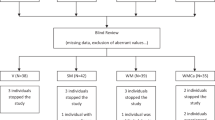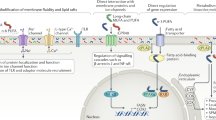Abstract
Background/Objectives:
The objective of this study was to evaluate the impact of three specific ruminant (R) milk fats resulting from modification of the cow's diet on cardiovascular risk factors in healthy volunteers. R-milk fats were characterized by increased content in total trans fatty acids (R-TFAs) and parallel decrease in saturated fatty acids (SFAs).
Subjects/Methods:
A total of 111 healthy, normolipemic men and women have been recruited for a monocentric, randomized, double-blind and parallel intervention, 4-week controlled study. Volunteers consumed three experimental products (butter, dessert cream and cookies) made with one of the three specific milk fats (55 g fat per day). During the first week (run-in period), the subjects consumed on a daily basis dairy products containing 72% SFA/2.85% R-TFA (called ‘L0’). For the next 3 weeks of the study (intervention period), the first group continued to consume L0 products. The second group received dairy products containing 63.3% SFA/4.06% R-TFA (called ‘L4’), and the third group received dairy products containing 56.6% SFA/12.16% R-TFA (called ‘L9’).
Results:
Plasma concentrations of high-density lipoprotein (HDL)-cholesterol were not significantly altered by either diet (P=0.38). Compared to L0 diet, L4 diet contributed to reduce low-density lipoprotein (LDL)-cholesterol (−0.14±0.38 mmol/l, P=0.04), total cholesterol (−0.13±0.50 mmol/l, P=0.04), LDL-cholesterol/HDL-cholesterol (−0.14±0.36, P=0.03) and total cholesterol/HDL-cholesterol (−0.18±0.44, P=0.02).
Conclusions:
Different milk fat profiles can change cardiovascular plasma parameters in human healthy volunteers. A limited increase of the R-TFA/SFA ratio in dairy products is associated with an improvement in some cardiovascular risk factors. However, a further increase in R-TFA/SFA ratio has no additional benefit.
This is a preview of subscription content, access via your institution
Access options
Subscribe to this journal
Receive 12 print issues and online access
$259.00 per year
only $21.58 per issue
Buy this article
- Purchase on Springer Link
- Instant access to full article PDF
Prices may be subject to local taxes which are calculated during checkout


Similar content being viewed by others
References
Afssa (2005). Risques et bénéfices pour la santé des acides gras trans apportés par les aliments—Health risks and benefits of trans fatty acids in food—Recommendations (synthesis), pp. 1–217. AFSSA, Maison-Alfort.
Ascherio A, Katan MB, Zock PL, Stampfer MJ, Willett WC (1999). Trans fatty acids and coronary heart disease. N Engl J Med 340, 1994–1998.
Baylin A, Kabagambe EK, Ascherio A, Spiegelman D, Campos H (2003). High 18:2 trans-fatty acids in adipose tissue are associated with increased risk of nonfatal acute myocardial infarction in Costa Rican adults. J Nutr 133, 1186–1191.
Booker CS, Mann JI (2008). Trans fatty acids and cardiovascular health: translation of the evidence base. Nutr Metab Cardiovasc Dis 18, 448–456.
Chardigny JM, Destaillats F, Malpuech-Brugere C, Moulin J, Bauman DE, Lock AL et al. (2008). Do trans fatty acids from industrially produced sources and from natural sources have the same effect on cardiovascular disease risk factors in healthy subjects? Results of the trans Fatty Acids Collaboration (TRANSFACT) study. Am J Clin Nutr 87, 558–566.
Chardigny JM, Malpuech-Brugere C, Dionisi F, Bauman DE, German B, Mensink RP et al. (2006). Rationale and design of the TRANSFACT project phase I: a study to assess the effect of the two different dietary sources of trans fatty acids on cardiovascular risk factors in humans. Contemp Clin Trials 27, 364–373.
Chilliard Y, Ferlay A (2004). Dietary lipids and forages interactions on cow and goat milk fatty acid composition and sensory properties. Reprod Nutr Dev 44, 467–492.
Dalainas I, Ioannou HP (2008). The role of trans fatty acids in atherosclerosis, cardiovascular disease and infant development. Int Angiol 27, 146–156.
European Heart Network (2008). European cardiovascular disease statistics. In: Allender S, Scarborough P, Peto V, Rayner M, Leal J, Luengo-Fernandez R et al. (eds), 2008 edn. European Heart Network: Brussels. pp 7–8.
Gebauer SK, Psota TL, Harris WS, Kris-Etherton PM (2006). n-3 fatty acid dietary recommendations and food sources to achieve essentiality and cardiovascular benefits. Am J Clin Nutr 83, 1526S–1535S.
Gebauer SK, Psota TL, Kris-Etherton PM (2007). The diversity of health effects of individual trans fatty acid isomers. Lipids 42, 787–799.
Hu FB, Stampfer MJ, Manson JE, Rimm E, Colditz GA, Rosner BA et al. (1997). Dietary fat intake and the risk of coronary heart disease in women. N Engl J Med 337, 1491–1499.
Jakobsen MU, Overvad K, Dyerberg J, Heitmann BL (2008). Intake of ruminant trans fatty acids and risk of coronary heart disease. Int J Epidemiol 37, 173–182.
Katan MB, Zock PL, Mensink RP (1995). Trans fatty acids and their effects on lipoproteins in humans. Annu Rev Nutr 15, 473–493.
Mansour MP, Li D, Sinclair AJ (2001). The occurrence of trans-18:1 isomers in plasma lipids classes in humans. Eur J Clin Nutr 55, 59–64.
Mensink RP, Zock PL, Kester AD, Katan MB (2003). Effects of dietary fatty acids and carbohydrates on the ratio of serum total to HDL cholesterol and on serum lipids and apolipoproteins: a meta-analysis of 60 controlled trials. Am J Clin Nutr 77, 1146–1155.
Motard-Belanger A, Charest A, Grenier G, Paquin P, Chouinard Y, Lemieux S et al. (2008). Study of the effect of trans fatty acids from ruminants on blood lipids and other risk factors for cardiovascular disease. Am J Clin Nutr 87, 593–599.
Mozaffarian D, Clarke R (2009). Quantitative effects on cardiovascular risk factors and coronary heart disease risk of replacing partially hydrogenated vegetable oils with other fats and oils. Eur J Clin Nutr 63 (Suppl 2), S22–S33.
Poppitt SD, Keogh GF, Mulvey TB, McArdle BH, MacGibbon AK, Cooper GJ (2002). Lipid-lowering effects of a modified butter-fat: a controlled intervention trial in healthy men. Eur J Clin Nutr 56, 64–71.
Rivellese AA, Maffettone A, Vessby B, Uusitupa M, Hermansen K, Berglund L et al. (2003). Effects of dietary saturated, monounsaturated and n-3 fatty acids on fasting lipoproteins, LDL size and post-prandial lipid metabolism in healthy subjects. Atherosclerosis 167, 149–158.
Roy A, Ferlay A, Chilliard Y (2006). Production of butter fat rich in trans10-C18:1 for use in biomedical studies in rodents. Reprod Nutr Dev 46, 211–218.
Scientific Panel on Dietetic Products NaA (2004). Opinion of the Scientific Panel on Dietetic Products, Nutrition and Allergies on a request from the Commission related to the presence of trans fatty acids in foods and the effect on human health of the consumption of trans fatty acids (Request No EFSA-Q-2003-022). EFSA J 81, 1–49.
Seidel C, Deufel T, Jahreis G (2005). Effects of fat-modified dairy products on blood lipids in humans in comparison with other fats. Ann Nutr Metab 49, 42–48.
Stampfer MJ, Sacks FM, Salvini S, Willett WC, Hennekens CH (1991). A prospective study of cholesterol, apolipoproteins, and the risk of myocardial infarction. N Engl J Med 325, 373–381.
Stender S, Dyerberg J (2003). The influence of trans fatty acids on health. 4th edn. A Report from the Danish Nutrition Council Publication. Danish Nutrition Council: Copenhagen, Denmark. Publication No. 34.
Stender S, Dyerberg J (2004). Influence of trans fatty acids on health. Ann Nutr Metab 48, 61–66.
Tholstrup T, Raff M, Basu S, Nonboe P, Sejrsen K, Straarup EM (2006). Effects of butter high in ruminant trans and monounsaturated fatty acids on lipoproteins, incorporation of fatty acids into lipid classes, plasma C-reactive protein, oxidative stress, hemostatic variables, and insulin in healthy young men. Am J Clin Nutr 83, 237–243.
Tricon S, Burdge GC, Jones EL, Russell JJ, El-Khazen S, Moretti E et al. (2006). Effects of dairy products naturally enriched with cis-9,trans-11 conjugated linoleic acid on the blood lipid profile in healthy middle-aged men. Am J Clin Nutr 83, 744–753.
Vermunt SH, Beaufrere B, Riemersma RA, Sebedio JL, Chardigny JM, Mensink RP (2001). Dietary trans alpha-linolenic acid from deodorised rapeseed oil and plasma lipids and lipoproteins in healthy men: the TransLinE Study. Br J Nutr 85, 387–392.
Yu S, Derr J, Etherton TD, Kris-Etherton PM (1995). Plasma cholesterol-predictive equations demonstrate that stearic acid is neutral and monounsaturated fatty acids are hypocholesterolemic. Am J Clin Nutr 61, 1129–1139.
Acknowledgements
This work was supported by the ‘ANR—Agence Nationale de la Recherche—The French National Research Agency’ under the ‘Programme National de Recherche en Alimentation et nutrition humaine’, Project ‘ANR-05-PNRA-no. 5.E.24’. We are indebted to Professor Yves Boirie, PU-PH, MD, who was the principal investigator. We thank the two co-investigators Ms Laporte and Gérard, Nöelle Mathieu for nursing assistance and Ms Caille and Brandolini who assessed the dietician follow-up and Mr Manlhiot for cooking. We thank Ms Chalancon, Laillet, Rousset and Mrs Giraudet and Rigaudière for their technical assistance. We also thank Yves Chilliard and Pierre Capitan (INRA, F-63122, France) for assistance in the analyses of the milk fatty acids.
Author information
Authors and Affiliations
Corresponding author
Ethics declarations
Competing interests
The authors declare no conflict of interest.
Rights and permissions
About this article
Cite this article
Malpuech-Brugère, C., Mouriot, J., Boue-Vaysse, C. et al. Differential impact of milk fatty acid profiles on cardiovascular risk biomarkers in healthy men and women. Eur J Clin Nutr 64, 752–759 (2010). https://doi.org/10.1038/ejcn.2010.73
Received:
Revised:
Accepted:
Published:
Issue Date:
DOI: https://doi.org/10.1038/ejcn.2010.73
Keywords
This article is cited by
-
Saturated Fat and Cardiovascular Disease: A Review of Current Evidence
Current Cardiovascular Risk Reports (2013)



